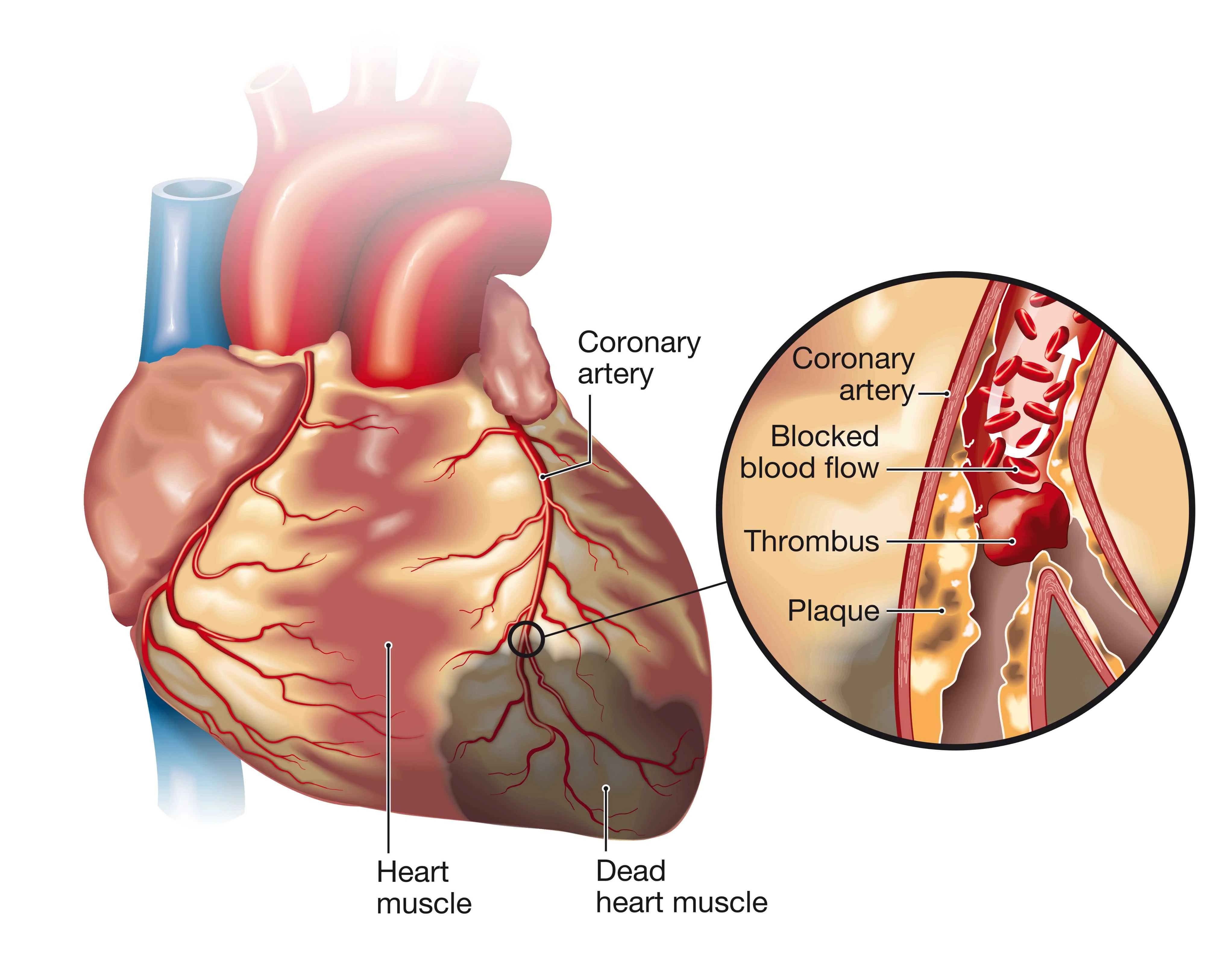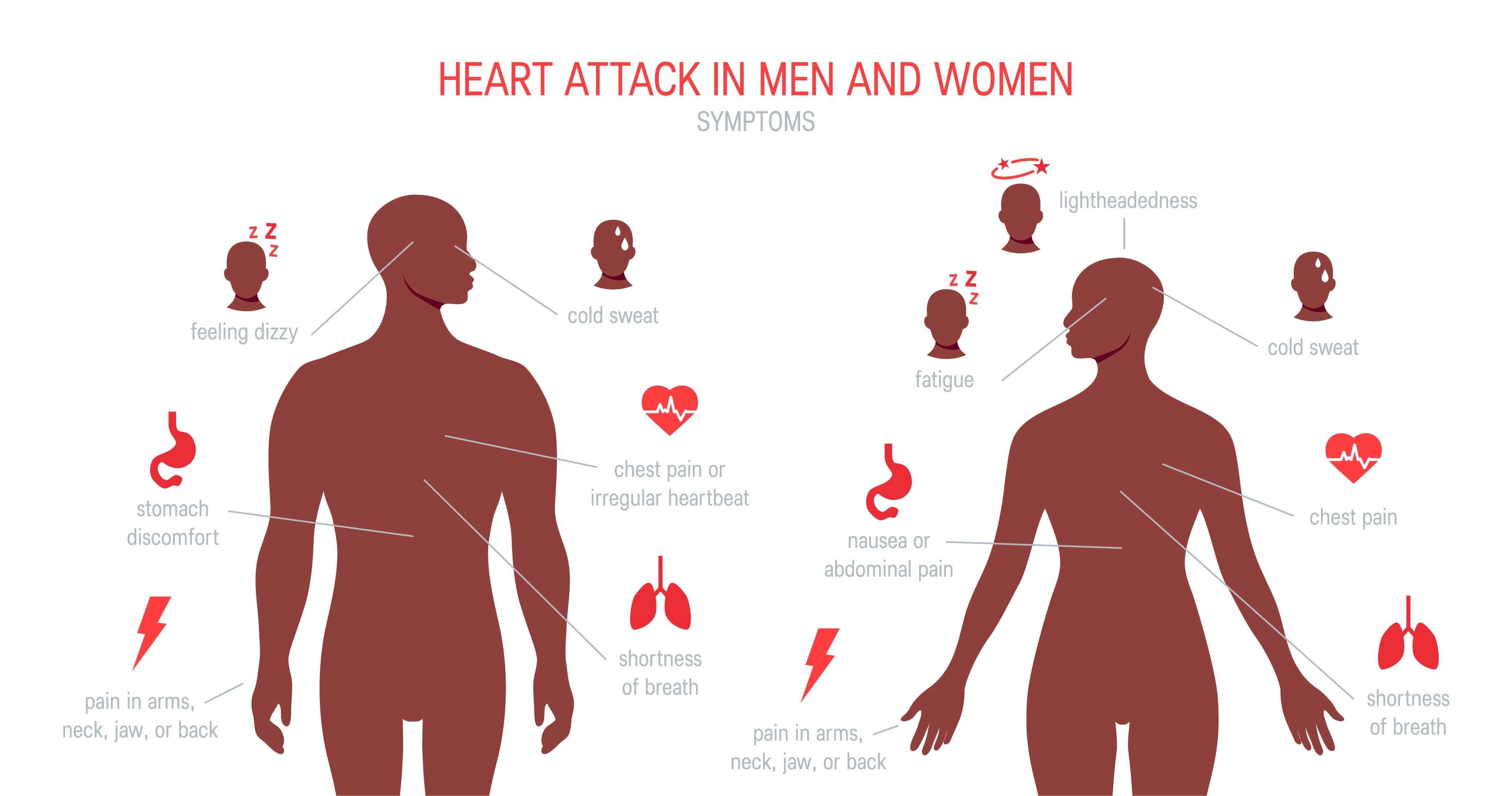Symptoms of a Heart Attack in Men

Imagine a scenario where knowledge becomes a powerful shield, where understanding subtle cues can make the difference between life and tragedy. In the realm of health, particularly concerning men's well-being, the ability to recognise the silent whispers of the body holds profound significance. Recognising Symptoms of Heart Attack in Men is a crucial step towards ensuring one's well-being. This article serves as a comprehensive guide, shedding light on the subtle yet vital indicators that can help you or a loved one take timely action, potentially saving lives. Join us as we explore the signs and symptoms, demystify the complexities, and empower you with the knowledge needed to protect your heart's health.
Read more about it below or you may book an appointment for a cardiac evaluation with one of our cardiologists or contact us for further details to schedule your test.
Introduction to Heart Attack
A heart attack, medically known as a myocardial infarction, is a life-threatening condition that occurs when blood flow to the heart muscle is severely reduced or blocked, usually due to the formation of a blood clot. It's crucial to recognise the symptoms of a heart attack in men promptly as it can mean the difference between life and death.

Definition of a Heart Attack
A heart attack occurs when the heart muscle is deprived of oxygen-rich blood, leading to the death of heart cells. This can cause significant damage to the heart and potentially result in heart failure if not treated promptly.
Importance of Early Recognition
Early recognition of a heart attack is paramount. The sooner medical help is sought, the better the chances of survival and minimising heart muscle damage. Time is of the essence when dealing with a heart attack.
Gender Differences in Heart Attack Symptoms
While both men and women can experience heart attacks, there are some differences in the way symptoms manifest. Understanding these gender-specific differences is vital, as it can help identify a heart attack in men more accurately. Men often experience classic symptoms such as chest pain and radiating discomfort, which might be having a heart attack warning signs.
In contrast, women might encounter more subtle signs like nausea, fatigue, or back pain, which could also indicate signs of heart attack. These differences highlight the need for tailored awareness campaigns and medical education to ensure that everyone, regardless of gender, can identify the symptoms that cause a heart attack and seek immediate medical attention when necessary. Understanding these nuances is a vital step towards ensuring the well-being of all individuals.
Common Symptoms of Heart Attack
It is crucial to prioritise your health and recognise the warning signs of a heart attack. These symptoms act like a fire alarm, signalling the need for immediate action. Ignoring them could be detrimental, so take action right away to potentially save your life. Always remember, that your health is invaluable. Know the signs, that heart attacks are sudden, and understanding these early warnings can be the key to getting timely help and treatment.
Chest Pain or Discomfort
Chest pain or discomfort is one of the most common symptoms of a heart attack in men. It often feels like a tightness, pressure, or squeezing sensation in the chest. This discomfort may last over a few minutes or come and go, signalling chances of having a heart issue. Remember, heart attacks involve discomfort and heart attack symptom is chest pain, best to call for help immediately if you notice these symptoms.
The chest pain associated with a heart attack is typically located in the centre of the chest, behind the breastbone. It can radiate to the left arm, neck, jaw, or back, indicating potential heart damage. The intensity of the pain can vary from person to person, but it's crucial to understand that heart disease is the leading cause of such symptoms.
Disregarding chest discomfort is a serious oversight, as any persistent chest pain should be treated with utmost concern, as it may indicate a heart attack. Seeking immediate medical attention is imperative in such cases. This approach is vital in managing the chances of having a heart issue and ensuring timely intervention.
Shortness of Breath
Another symptom of a heart attack in men is shortness of breath. It may occur with or without chest pain and can be sudden and severe. When the heart muscle is damaged during an early heart attack, it can't pump blood effectively, leading to reduced oxygen delivery to the body. This lack of oxygen can cause breathlessness, indicating the need to begin treatment promptly.
It's essential to differentiate between normal breathlessness and heart attack-related breathlessness. Normal breathlessness might occur after strenuous physical activity or in high-altitude environments, but it generally resolves with rest or a change in circumstances.
On the other hand, heart attack-related breathlessness tends to manifest suddenly, without any apparent cause, and can be notably severe. If you find yourself struggling to catch your breath without a clear explanation, it could be a sign of a heart attack or stroke. Recognising these heart attack signs early can be a lifesaver, prompting you to seek immediate medical assistance when necessary.
Radiating Pain
Radiating pain is a distinctive symptom of a heart attack in men. This pain can spread from the chest to the left arm, neck, jaw, or back. It's crucial to note that mild pain, in one or both arms, symptoms can vary from person to person when diagnosed with heart issues.
The radiation of pain to these areas occurs because the heart and these body parts share common nerve pathways. Pain in these regions should raise suspicion of a heart attack.
Understanding the significance of radiating pain can save lives. If you or someone you know encounters such pain, it should immediately raise suspicion of a heart attack. In such situations, seeking emergency medical attention without delay is the wisest course of action.
Atypical Symptoms in Men
While chest pain is the hallmark symptom of a heart attack, some men may experience atypical symptoms, which can be confusing. Recognising these atypical symptoms is just as important as understanding chest pain, as they can also be indicative of a heart attack risk. It's essential to stay vigilant and consider the possibility of a heart-related issue if you experience any unusual discomfort or symptoms that could signal the beginning of heart attack symptoms. Even if these signs don't fit the stereotypical image of a heart attack, seeking emergency medical services promptly could be crucial due to heart complications.
Nausea, Vomiting, or Indigestion
Nausea, vomiting, or indigestion can occur in some cases of heart attack in men. These digestive symptoms may be accompanied by discomfort in the upper abdomen.
Digestive symptoms can be linked to a heart attack because the heart and stomach share nerve connections. When the heart is under stress, it can send signals to the stomach, leading to these symptoms.
Atypical digestive symptoms can include a feeling of fullness, bloating, or even heartburn. If these symptoms occur suddenly and without a known cause, it's essential to consider the possibility of a heart attack.
Fatigue or Lightheadedness
Fatigue or lightheadedness can be subtle signs of a heart attack in men. Fatigue may persist even after rest, and lightheadedness can occur suddenly. These symptoms might not immediately signal to everyone that it’s a heart attack, severe symptoms that require immediate attention.
Unusual tiredness can be a result of the heart's inability to pump blood effectively. This can lead to decreased oxygen delivery to the body, causing fatigue. It's crucial to recognise that such fatigue, when inexplicable or disproportionate to the level of activity, could indicate it’s a heart attack, with severe symptoms not to be overlooked.
Lightheadedness can be heart-related because it often occurs as a consequence of reduced blood flow to the brain, a condition that can be triggered during a heart attack. When a heart attack happens, the heart muscle may not be able to effectively pump blood, leading to a decreased supply of oxygen-rich blood to various parts of the body, including the brain.
As the brain relies on a continuous supply of oxygen and nutrients carried by the bloodstream, any disruption in this supply can lead to lightheadedness or a feeling of dizziness.
Silent Heart Attacks
Silent heart attacks are a concerning phenomenon. These are heart attacks that occur with minimal or no symptoms, making them challenging to detect. The absence of conspicuous symptoms makes them all the more insidious, emphasising the importance of regular health check-ups and vigilant monitoring of cardiovascular risk factors to identify and address these hidden threats to heart health.
Define Silent Heart Attacks
Silent heart attacks are heart attacks that go unnoticed because the symptoms are mild or absent. Men can experience these without realising they have had a heart attack. Despite their subtle nature, silent heart attacks can still cause damage to the heart muscle, making it crucial to understand their existence and risk factors to ensure early detection and preventive measures.
Risk Factors for Silent Heart Attacks
Silent heart attacks, though often unnoticed, can pose a significant danger to one's heart health. Understanding the contributors to this risk is vital. The primary factors that elevate the likelihood of experiencing these stealthy cardiac events include:
- High Blood Pressure: Uncontrolled hypertension can quietly damage the heart over time, making it susceptible to silent heart attacks. If you experience any mild pain or discomfort, seeking help right away is crucial to prevent severe outcomes, including sudden cardiac arrest.
- High Cholesterol Levels: Elevated cholesterol levels can lead to the buildup of plaque in the arteries, increasing the risk of silent heart attacks.
- Smoking: Tobacco use, including smoking, significantly raises the risk of these covert cardiac events. Smokers should be vigilant of any unusual symptoms and seek help right away to avert the risk of sudden cardiac arrest.
- Diabetes: Managing blood sugar levels is crucial, as diabetes is a major contributor to the risk of silent heart attacks. Diabetics should monitor for any mild pain or discomfort and get help right away to protect against severe heart issues.
Awareness of common heart attack symptoms is essential, even though they may not always be apparent in silent heart attacks. These factors can silently build up over time, increasing vulnerability. Regular monitoring and adopting preventive measures are essential steps in mitigating the chances of these covert cardiac events and safeguarding your heart's well-being.
Importance of Detecting Silent Heart Attacks
Detecting silent heart attacks is of paramount importance because, despite their subtle nature, they can inflict significant damage on the heart muscle. These covert cardiac events may go unnoticed, allowing the underlying heart condition to persist and worsen over time.
To safeguard your heart health effectively, it is imperative to prioritise regular health check-ups and diligently monitor risk factors. By remaining vigilant and proactively addressing potential risk factors through consistent medical care, individuals can take crucial steps toward preserving their heart health and preventing the potentially severe and long-term consequences of silent heart attacks.
Recognizing Symptoms in Men vs. Women
Both men and women need to understand that heart attack symptoms can differ. In men, symptoms often include chest pain, while women may experience subtler signs like nausea, fatigue, or back pain. Knowing these distinctions is essential for early recognition and prompt medical attention. Remember, regardless of gender, if you or someone you know is experiencing unusual symptoms, it's crucial to seek immediate help. Your health and well-being are worth every precaution.
How Symptoms May Differ in Men

When it comes to heart attack symptoms, it's important to note that men may experience different signs than women. While both genders may encounter chest discomfort, men often describe more traditional symptoms like a tightness in the chest that can spread to the left arm, neck, jaw, or back.
However, what sets men apart are the less common symptoms they might not immediately associate with a heart issue, such as indigestion, nausea, unusual tiredness, or feeling lightheaded. Recognising these distinctions is crucial, as it empowers men to identify potential heart problems early, seek prompt medical attention, and take proactive measures to protect their heart health.
The Need for Gender-Specific Awareness
Recognising these gender differences is crucial for accurate diagnosis and timely intervention. Healthcare providers and the public should be aware of these variations in heart attack symptoms.
Risk Factors for Heart Attack in Men
To safeguard your heart and overall well-being, it's essential to recognise the various risk factors that can increase the likelihood of a heart attack in men. These factors encompass a range of elements, from lifestyle choices to genetic predispositions, all of which play a pivotal role in heart health. By identifying and addressing these risk factors, you can take proactive steps towards reducing your risk of a heart attack and leading a heart-healthy life.
Identify Common Risk Factors
Understanding the common risk factors associated with heart attacks in men is the first line of defence in heart health. These risk factors serve as early indicators, allowing individuals to take proactive steps to mitigate their risk. Some of the primary risk factors include:
Age
As men age, the risk of heart attack increases. Middle-aged and older men are at higher risk. This underscores the importance of maintaining a healthy lifestyle and regular health check-ups, especially as we advance in years, to proactively address any potential cardiovascular concerns.
Family History
A family history of heart disease can significantly increase the likelihood of a heart attack in men. It's not just a matter of genetics; it's a roadmap of potential cardiovascular challenges. If heart disease runs in your family, it's essential to be extra vigilant, as it can increase your likelihood of experiencing a heart attack. However, awareness of your family history also empowers you to take proactive steps towards heart health, such as early screenings and lifestyle adjustments.
High Blood Pressure
High blood pressure, also known as hypertension, is a common and often silent threat to heart health. When left uncontrolled, it can lead to a host of cardiovascular issues, including heart attacks and strokes.
Regular monitoring of blood pressure levels and adopting lifestyle modifications, such as a heart-healthy diet and exercise, are pivotal in managing and mitigating this significant risk factor.
High Cholesterol
High cholesterol levels in the blood can quietly set the stage for heart-related issues. This condition, often devoid of noticeable symptoms, can lead to the gradual buildup of plaque in the arteries, narrowing them and restricting blood flow.
Over time, this can increase the risk of heart attacks and other cardiovascular problems. It underscores the importance of routine cholesterol screenings and lifestyle modifications to maintain optimal heart health.
Smoking
Smoking, a well-known risk factor for heart attacks, deserves our utmost attention. This harmful habit not only damages the lungs but also significantly elevates the risk of coronary artery disease, another heart attack trigger. Smoking leads to the build-up of plaque in the arteries, including those supplying blood to the heart, narrowing them and impeding the flow of blood. This can severely affect part of the heart muscle, compromising its function and health.
Moreover, it raises blood pressure, increases the heart's workload, and reduces the amount of oxygen the heart receives. To protect your heart, quitting smoking is an essential step in mitigating this potent risk factor. Remember, it's never too late to quit, and the benefits to your heart health are immediate and profound.
Diabetes
Diabetes, a medical condition characterized by elevated blood sugar levels, poses a significant risk for heart attacks. When blood sugar levels remain consistently high, they can lead to the buildup of fatty deposits in the arteries, making them narrower and less flexible.
This narrowing of the arteries can impede blood flow to the heart, increasing the likelihood of a heart attack. Therefore, managing and controlling diabetes through lifestyle changes and medical care is essential in reducing the risk of heart attacks in individuals with this condition.
Obesity
Excess body weight, or obesity, poses a significant risk to heart health.
Obesity is often linked to other risk factors like high blood pressure and diabetes, further increasing the likelihood of heart problems. Maintaining a healthy weight through balanced nutrition and regular physical activity is essential for reducing this risk and safeguarding your heart.
Lifestyle Factors
In our daily routines, the way we live can have a big impact on our health. Let's explore how our lifestyle choices can affect our well-being.
Diet
The heart-healthy diet is a cornerstone of cardiovascular wellness. A diet rich in saturated and trans fats can elevate the risk of heart disease, leading to artery blockages and potential heart attacks.
In contrast, embracing a heart-healthy diet places fresh fruits and vegetables at its forefront. These nutrient-packed options supply vital vitamins, minerals, and fibre essential for cardiovascular health. Whole grains like brown rice and whole wheat bread are also crucial components, aiding in cholesterol control and overall heart well-being. Adopting this dietary approach empowers individuals to take charge of their heart health and reduce the risk of heart disease, promising a longer and healthier life.
Physical Inactivity
Physical inactivity is a potent contributor to heart disease, as it can lead to weight gain and increased levels of bad cholesterol. Regular exercise, on the other hand, strengthens the heart, improves circulation, and helps maintain a healthy weight, significantly lowering the risk of heart attacks. So, making exercise a part of your daily life is not just beneficial but crucial for heart health.
Stress
Stress is more than just an emotional burden; it can physically strain your heart. The release of stress hormones can lead to increased blood pressure and inflammation, both of which are detrimental to cardiovascular health. Engaging in relaxation techniques like meditation, deep breathing exercises, or yoga can be instrumental in alleviating stress and safeguarding your heart's well-being.
Alcohol Use
Alcohol use, especially in excess, can have detrimental effects on heart health. It not only raises blood pressure but also disrupts the normal rhythm of the heart, increasing the risk of heart problems such as arrhythmias and cardiomyopathy. To safeguard your heart, it's crucial to practice moderation and be mindful of alcohol consumption.
Prevention and Early Intervention
Preventing heart attacks in men involves a combination of lifestyle modifications and early intervention. These strategies not only reduce the risk of heart disease but also provide a vital safety net, ensuring that any potential issues are addressed promptly to safeguard heart health.
Lifestyle Modifications
By making simple changes to your daily routine, you can greatly enhance your overall health and well-being. Take control of your life by implementing practical lifestyle modifications that promote a healthier you.
Diet and Nutrition Tips
- Consume a diet low in saturated and trans fats.
- Increase your intake of fruits, vegetables, and whole grains.
- Limit salt and sugar intake.
- Stay hydrated with plenty of water.
Regular Exercise Recommendations
- Aim for at least 150 minutes of moderate-intensity aerobic exercise per week.
- Include strength training exercises in your routine.
- Consult a fitness professional for guidance.
Stress Reduction Strategies
- Practice stress-reduction techniques such as mindfulness and deep breathing.
- Prioritise relaxation and self-care.
Smoking Cessation
- Seek support and resources to quit smoking.
- Consider nicotine replacement therapy if needed.
Conclusion
In conclusion, recognizing the symptoms of heart attack in men is crucial for early intervention and improved outcomes. Chest pain, shortness of breath, and radiating pain are common indicators, but atypical symptoms like nausea, fatigue, and lightheadedness can also occur. Understanding risk factors and implementing lifestyle modifications are key to preventing heart attacks.
At The Harley Street Heart and Vascular Centre, our team of dedicated cardiologists is at the forefront of innovative cardiac care. With state-of-the-art facilities and a commitment to personalized treatment, we prioritize your heart's health above all else. Book an appointment or teleconsultation today to put your heart's well-being first.
Frequently Asked Questions About Symptoms of Heart Attack In Men
What Are the First Signs of a Heart Attack in a Man?
The first signs of a heart attack in a man often include chest pain or discomfort, which may feel like tightness, pressure, or squeezing in the chest. This discomfort can radiate to the left arm, neck, jaw, or back.
What Does a Mild Heart Attack Feel Like for a Man?
A mild heart attack in a man may have symptoms that are less severe or less prolonged than a full-blown heart attack. These symptoms can include mild chest discomfort, shortness of breath, or even atypical symptoms like nausea or fatigue.
How Do I Know if I’m Having a Heart Attack As A Man?
If you're wondering if you're having a heart attack as a man, pay close attention to the symptoms. The key indicators are chest pain or discomfort, shortness of breath, and radiating pain to the left arm, neck, jaw, or back.
How Long Can a Man Have Symptoms Before a Heart Attack?
The duration of symptoms before a heart attack can vary from person to person. Some individuals may experience warning signs for days or even weeks before a heart attack occurs. Others may have sudden, intense symptoms.
What Are the Symptoms of Heart Attack in Men?
The symptoms of heart attack in men can include:
- Chest pain or chest discomfort
- Shortness of breath
- Radiating pain to the left arm, neck, jaw, or back
- Atypical symptoms like nausea, vomiting, or indigestion
- Fatigue
- Lightheadedness

